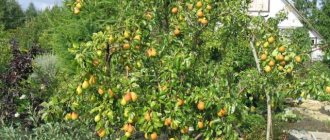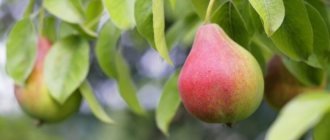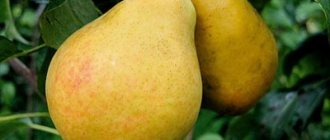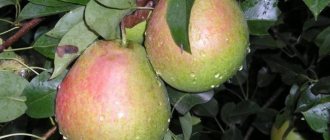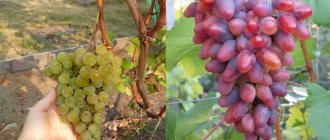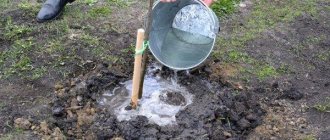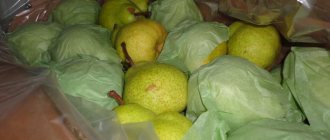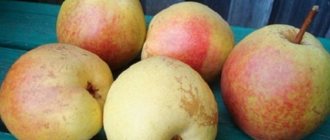Description of the red-sided pear
The article provides a description and photo of the Red-sided pear variety, which is classified as a variety for growing in difficult climatic conditions. Initially, it was supposed to be grown in the Urals, for which it was zoned. Today it is not uncommon in the gardens of Altai, Western Siberia, the Volga-Vyatka and North-Western regions. The frost-resistant and unpretentious variety Krasnobokaya was appreciated in Belarus and Ukraine.
Interesting fact!
During the period of agricultural testing, the Red-sided pear showed one of the highest frost resistance results. Its root system withstood temperatures of 43 degrees below zero. Only the tips of the branches were damaged.
Red-sided pear rarely grows higher than 4 m. The crown of the trees is spreading, rounded with rare powerful shoots. Skeletal branches grow at right angles to the trunk, gradually bending upward. The bark is rough, prone to cracking, and gray-brown in color. This year's young shoots are smoother and have a richer brown color.
The leaves are large, regular ellipse-shaped, with finely serrated edges. The leaf plates themselves are slightly corrugated, rich green in color. The formation of inflorescences is mixed. Large, pubescent buds form on trunk rings, fruit twigs and even the tips of young shoots. The flowers are cup-shaped, with oval petals of a light pink hue.
The Red-sided pear is characterized by equal-sized, symmetrical fruits of a classic pear shape with a wide base. Their average weight is 140-150 grams. There are also specimens weighing 180 grams. But this is rather an exception.
During the period of pouring and technical maturity, the skin is emerald green in color. As it ripens, yellow hues appear. And as a finishing touch, fully ripened fruits have a light crimson blush. Subcutaneous points are very weakly expressed.
The skin of the Red-sided pear fruit is thin, smooth, and somewhat oily to the touch. However, it is dense enough so that fruits collected on time can be stored for a long time. The fruits are white when cut. The pulp is very juicy, with a bright sour-sweet taste and a small amount of astringency in the aftertaste. However, many note its fine-grained structure. However, the Red-sided pear received a fairly high tasting score of 4.5 points out of 5 possible.
Diseases and pests
The Krasnobokaya variety is resistant to a significant number of pests and diseases, which greatly simplifies plant care. But under unfavorable factors, the tree can be affected by certain ailments.
Diseases characteristic of Red-sided - table
| Diseases | Symptoms | Fighting methods | Prevention |
| Fruit rot |
| Treatment when the leaves bloom with the drug Skor (1 ampoule per 10 l of water), after flowering, use the drug Horus (1 sachet per 10 l). | Removing all mummified fruits from the tree in the fall. |
| Rust | Orange pads appear on the leaves. | Spraying before the flowering stage and after its completion with Khoma solution (80 g per 10 l), after harvesting the fruits, using 1% Bordeaux mixture. | Removing fallen leaves and then burning them. |
| Black cancer |
|
| Collection and destruction of leaves and dried fruits in autumn. |
Typical ailments of the variety in the photo
Fruit rot destroys crops
Rust inhibits tree development
Black cancer can destroy a tree in a few years
The most common pear pests - table
| Pests | Signs | Ways to fight | Prevention measures |
| Winter moth |
| Treatment with Nitrafen (200 g per 10 l) or N30 (300 g per 10 l). | Regular digging of the soil in the fall. |
| hawthorn | The pest eats leaves that curl and dry out. | Spraying when buds open with 0.5% Karbofos solution. |
|
| Ringed silkworm | The pest eats buds and leaves, leaving only bare branches. |
| |
| Pear flower beetle | The pest larvae completely eat up the buds. | Treatment before bud formation with Actellik (1 ampoule per 2 l) or Karbofos (60 g per 8 l). |
Photo gallery: insects parasitizing on Krasnobokaya
Hawthorn is a dangerous pest for tree foliage
Pear flower beetle feeds on buds and leaves
The winter moth is a polyphagous pest that destroys crops
The ringed silkworm oppresses tree stems, leading to their complete depletion
Characteristics of the red-sided pear
According to reviews from gardeners, the Red-sided pear is indeed a variety with Siberian hardening. He is not afraid of frosts down to 32-35 degrees. At the same time, the late flowering period and cold resistance allow it to preserve the formed ovaries in cold summer conditions. However, like most large-fruited varieties, the Red-sided pear requires regular watering. The variety cannot be characterized as drought-resistant.
One more point is worth noting. Red-sided pear fruits on the branches should not be allowed to overripe. Ripe pears fall off. Their shelf life is significantly reduced. And with timely harvesting, they reach 100 days. Fruits caught in the first autumn frosts are also poorly stored. For storage and transportation, it is better to collect Red-sided pears at the stage of technical maturity. They ripen well during storage, maintaining taste and commercial qualities, and are not afraid of transportation over long distances. Often in descriptions of photos and reviews of the Red-sided pear they say that this is a winter variety. This opinion is wrong. The crop is a late-autumn crop, with ripening dates occurring in mid-autumn. Fruiting is friendly. It is possible to collect fruits in one go using mechanical means.
Red-sided pear is considered a table variety. It is consumed fresh. It is also suitable for preparing desserts, fruit and vegetable salads, giving them a special piquancy. The fruits are also used as a filling or decoration for confectionery products. But more emphasis is placed on processing - compotes, juices, preserves and jams.
Pollinators for the red-sided pear
According to biologists, Red-sided pear is not a self-fertile variety. But without pollinating neighbors, the harvest will be less than stated. It is better to plant it next to varieties that have the same flowering time. Among them it is worth noting Severyanka or Povislaya.
Plant care
Watering a tree
The pear tree needs watering to obtain a quality harvest.
Watering a pear depends on the stage of its development. A young tree that has not yet entered the fruiting stage needs to be moistened once a week. 10 liters of water are poured under one plant. In this case, weather conditions should also be taken into account. If the soil is moistened by precipitation, the procedure is postponed until the soil dries.
The fruiting pear is watered twice a season: before flowering begins and after it ends. A tree requires 20–30 liters of water. You can water the pear using rotating sprayers or grooves. In the latter case, furrows 10 cm deep are dug around the tree, into which water is supplied. After watering, the tree trunk area is covered with a layer of humus or peat mulch 10–15 cm thick.
Feeding pears
Feeding the tree will allow you to get a bountiful harvest every year.
After the winter period, the pear needs nutrients. The scheme is as follows:
- In spring, 500 g of urea is added under the plant when loosening. If this fertilizer is not available, it can be replaced with a solution based on ammonium nitrate (40 g per 10 liters of water).
- At the flowering stage, the plant is fertilized again with urea, which activates the growing season (300 g for one pear). This substance can also be used for foliar feeding (50 g per 10 l).
- After flowering, the tree is sprayed with a solution of 50 g of nitrophoska, 1 g of sodium humate and 10 liters of water.
- In September-October, the tree is fertilized with a mixture of 1 tbsp. l. calcium, a similar amount of potassium, 2 tbsp. l. double superphosphate and 10 liters of water. After fertilizing, the soil in the tree trunk area is loosened by 10–12 cm.
Crown trimming
Crown formation improves yield and tree development
An equally important stage of care is pruning. The purpose of this procedure is the correct formation of the crown, improving access of sunlight to the branches and increasing fruiting. Pruning is carried out in the spring - from early March to April or in the fall (during October-November).
Important! In the southern regions, gardeners recommend carrying out the procedure until mid-March, and in the northern regions you need to wait until April.
The branches are removed using pruning shears. In this case, the narrow blade must be directed towards the part of the branch that is to be trimmed. This technique will avoid breaking the bark and cause less damage to the tree. Damaged areas are treated with garden varnish. It is prepared on the basis of melted lard, crushed rosin and alcohol, which are mixed in a ratio of 1:16:8. The first 2 components are placed on low heat and brought to a homogeneous state. Then the resulting mass is removed, cooled and alcohol is added.
Important! In the summer, pear trees are not pruned, except for the presence of diseased branches on the tree that need to be removed.
The formation of the crown begins in the second year after planting the pear. Four skeletal branches are left on the tree, located at the same distance and at an angle of 60°. They need to be cut to ¼ length. All other shoots are removed to the ring. The length of the conductor should be 20 cm longer than the remaining branches. During the first three years, it is necessary to eliminate tops - thick vertical shoots. They shade the crown and take away the tree’s strength. During this time, all growths are shortened by 20 cm.
With the onset of the fourth year, they begin to create the second tier. The central shoot is shortened by 7–8 buds. On the second tier, leave 3-4 branches, cut them to 1/3 of the length. The rest are removed at the ring level. The formation of the crown is carried out until the fifth year; subsequently, only thickening and weak shoots are eliminated. In the fall, sanitary pruning is carried out, that is, the removal of dry, damaged and diseased shoots.
Master class on pruning - video
Preparing for winter
Due to its high frost resistance, the Red-sided pear tolerates winter well. At the end of September or the first ten days of October, the tree needs to be watered with 40 liters of water. After this, the tree trunk area is mulched with peat or straw. The layer of material should be quite thick - up to 30 cm. In the spring, as soon as the snow cover melts, the mulch is removed.
Planting and care
The Red-sided pear variety is best planted in the fall, about 1.5-2.0 months before the onset of cold weather. In this case, it will have time to take root and receive enough moisture for further development. Spring planting is also possible in regions with frosty winters.
The hole for the Krasnobokaya pear seedling is prepared in advance.
- They dig a hole with a diameter and depth of 60-80 cm. The depth depends on the level of groundwater and the need to install a drainage layer.
- The removed soil is mixed with humus or aged compost, superphosphate and potash fertilizers are added.
- If the soil is heavy, it is mixed with sand, peat, and rotted sawdust. Much depends on the acidity of the soil. Peat and sawdust are not recommended for use on acidified soils.
- If necessary, arrange a drainage layer of crushed stone or broken brick.
- A fertile mixture is poured on top in the form of a mound.
- They dig in a peg and leave the hole for several weeks to shrink.
Immediately before planting, the root system of seedlings of the Krasnobokaya variety is soaked for a day in a solution of a growth stimulator. Then, dipped in clay mash, they are placed on a mound, straightening the roots. The hole is closed by periodically shaking the seedling. After planting, the root circle is watered abundantly, loosened and mulched with sawdust.
How to plant correctly
Pears are planted in spring or autumn
One of the prerequisites for growing Red-sided pear is planting nearby pollinators. Suitable varieties for this crop are Povislaya, Myth and Severyanka. The pear is planted on a well-lit, flat area with groundwater located at a distance of 1 m from the surface of the earth. You must retreat at least 3 m from buildings, and maintain a distance of 5 m between trees.
Important! The most suitable soil for Red-sided is considered to be loam, as well as chernozem and sandy loam soil.
The optimal time for planting will be the end of April-beginning of May or the first ten days of October. It is recommended to plant the crop in the northern regions in the spring, and in the southern regions in the fall.
Important! You should not choose low-lying areas for planting where groundwater is too close to the surface.
When buying a seedling, you need to carefully examine the surface of the trunk and branches. It is important to take into account the following features:
- There should be no spots, sagging, mechanical damage or sap on the plant. A healthy tree has smooth bark; if you pry it a little, the wound will be wet and green.
- It is not advisable to purchase a seedling with blossoming leaves. Such a plant has already expended a lot of energy on this process, which will negatively affect its ability to survive.
- After purchasing the tree, it must be properly preserved until planting. The roots should not be left in the open air; they dry out quickly. Therefore, they are moistened with water and placed in polyethylene or wrapped in a damp cloth.
- The plant should be stored in a cool room.
- If the root system has dried out, before planting it is immersed in water for 2–3 hours, but the roots cannot be kept in water constantly.
Red-sided planted in loamy, sandy loam soils or black soil
Planting a pear is done in the following order:
- The tree is planted in a previously prepared hole. This requirement is due to the fact that the soil settles over time. If the plant is placed in a hole immediately after digging, it will be pulled into the soil more than necessary. When planting in spring, the procedure is carried out in the autumn, and if planting is planned in the fall, then 2-3 weeks in advance.
- The pear hole should be 70 cm wide and 1 m deep. It must be filled with a composition of 20 kg of sand, 20 kg of humus, 1 cup of superphosphate and the fertile layer of soil removed during digging.
- During the planting process, a mound of soil is poured out of the soil in the center of the depression, a seedling is placed on it and the roots are well straightened.
- A stake 1 m long is installed near the plant. The hole is filled with soil.
- The root collar is left 5 cm above the soil surface. When filling the hole, it is advisable to shake the plant slightly so that the soil is distributed evenly and no voids are formed. The seedling is tied to a peg.
- After planting is completed, you need to form a hole with a diameter of 30–40 cm around the tree and water the plant with 20 liters of water.
- Then the ground is trampled down a little. It is not recommended to perform these steps in reverse order. If the soil is initially compacted and then watered, the compacted soil will retain moisture. This will also lead to the formation of air space between the roots, which will rot without contact with the ground.
- After this, to avoid loss of moisture, the tree trunk circle is mulched with compost, peat, straw or sawdust.
- The seedling is cut at a height of 50 cm from the soil.
Important! Fresh manure cannot be used when preparing the hole, as it will burn the roots.
How to plant a pear - video
Reviews from gardeners
Valentin Ivanovich, 67 years old
I have extensive gardening experience. The red-sided pear variety, in my opinion, is the best of all those previously tried. The Chelyabinsk region belongs to regions characterized by a difficult climate. In winter, frosts often drop below 30 degrees. Red-sided never froze. During the season I removed 100-120 kg from one tree. The fruits are very juicy, the sourness is barely noticeable. All desserts made from pears were a huge hit.
Maria Nikolaevna, 54 years old
My dacha is located 170 km from Moscow. Winters vary, but are mostly cold. Half of the planted young trees die. There have never been such problems with the Red-sided Pear variety. Every year we reap large harvests and have to distribute the surplus to neighbors and friends. The taste may not be outstanding, but fresh fruits are preserved until the New Year holidays. The plant requires attention for the first 3 years, after which every autumn and spring I introduce root feeding and water it if there is no rain for a long time. This is the main care.
Andrey, 39 years old
My grandfather's garden, along with the country house, was inherited by me. At first I didn’t think that many plants require careful care. My arrogance cost the lives of a third of the trees after the first year of my tutelage. In the second year, while I was studying the wisdom of gardening, the site became even more empty. The most durable were: Red-sided pear, blackberry and Antey apple tree. Despite the drought and lack of bait, the pear produced a consistently large harvest. Now I'm trying to pay more attention to the garden.
Watch a video about caring for pears:
Harvesting and further use
The technical maturity of the fruit falls in September, but the period largely depends on weather conditions. Most often, pear harvesting occurs at the end of September and continues until the second half of October. For long-term storage, slightly unripe specimens are selected, which were removed from the branches using a special device. When it hits the ground, the pulp and skin are deformed, which provokes rapid rotting of the damaged area.
The harvested crop is sent for processing or used as a dessert or addition to main courses. Culinary experts do not recommend making preparations by freezing fruits. After defrosting, the pulp loses its taste and becomes watery.
Advantages and disadvantages
Red-sided pear has many advantages with a minimum of disadvantages. The variety is noteworthy:
- excellent winter hardiness;
- resistance to adverse weather conditions;
- generous harvests;
- high quality fruits (excellent taste, presentable presentation, long shelf life, good transportability);
- unpretentiousness in cultivation and care;
- excellent immunity to diseases;
- annual fruiting.
This hybrid has practically no disadvantages. We can only note:
- tendency to crumble;
- the need for additional pollination.
Advantages
The trump cards of the variety are considered to be stable yield and attractive presentation.
Like most varieties, Red-sided has strengths and weaknesses when describing characteristics. Main advantages:
- high level of productivity;
- taste quality of fruits;
- presentable;
- one-dimensionality of fruit;
- keeping quality level;
- versatility in use;
- high level of winter hardiness;
- rapidity of development;
- lack of crown density;
- ease of care;
- resistance to scab.
It is worth noting that fruits are removed from the tree in the form of incomplete ripeness, then they ripen in the place of storage. Fruits are consumed fresh, jams, jams, compotes, desserts are prepared from them, and the whole fruit is used for preservation. As a rule, pears are eaten with the peel, since the peel contains the largest amount of nutrients. However, you need to eat pears after meals - thirty minutes later.
The variety withstands low temperatures - it can comfortably overwinter at temperatures of minus forty degrees . The rapidity of development is observed exactly when it is needed - the first five years after planting, thereby strengthening the skeleton and crown. Further development stops, and the tree devotes all its strength to stable and abundant fruiting.
Alkaline water - what is it? The benefits and harms of alkaline water
The work of pruning is reduced, which means there is less hassle. In addition, the pear is maximally resistant to scab, but this does not mean that preventive treatment should be ignored.
and disadvantages
The fruits have to be picked slightly unripe - after full ripening they begin to crumble.
In addition, in addition to its advantages, Red-sided has a number of disadvantages:
- presence of astringency at the time of removal;
- tendency to fruit shedding;
- the presence of granularity inside the pulp;
- sensitivity to drafts;
- demands on the type of soil.
Although the astringency goes away after some time, for many this becomes a disadvantage when choosing, so this point is considered a disadvantage, as is the fine grain inside the pulp . It is precisely because of the tendency to shed fruit that pears are removed from the branches in an unripe form.
In addition, when dropped, pears break, burst, and become wrinkled, which naturally reduces their marketable value.
